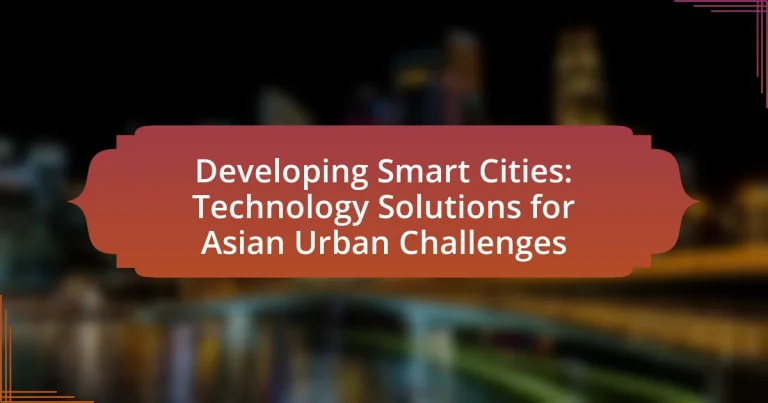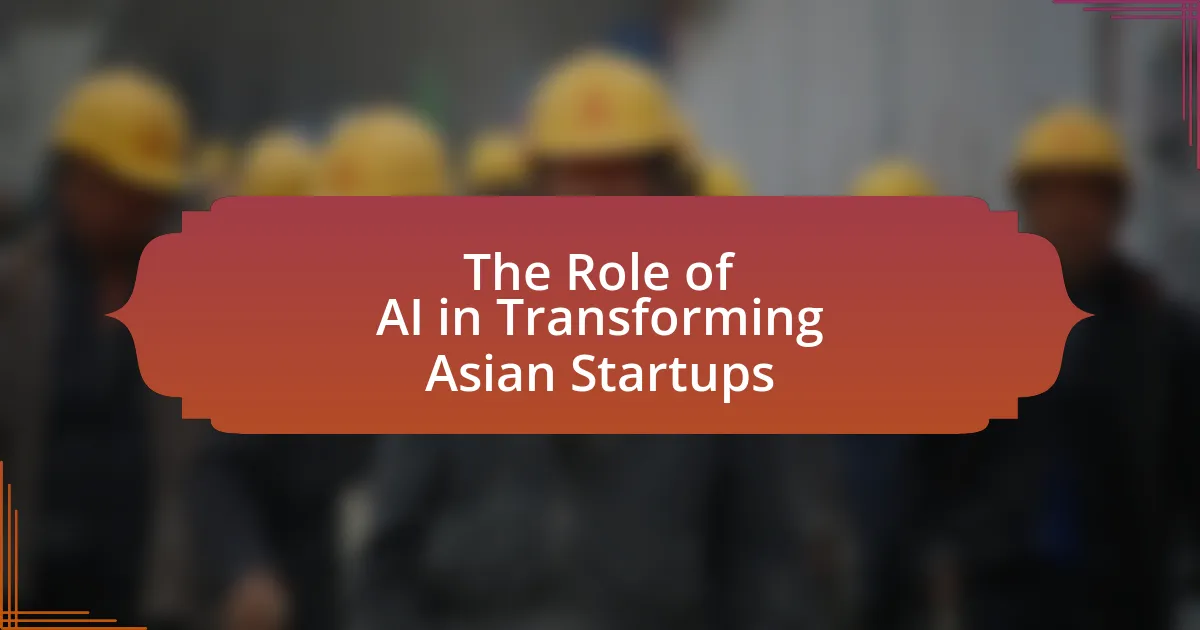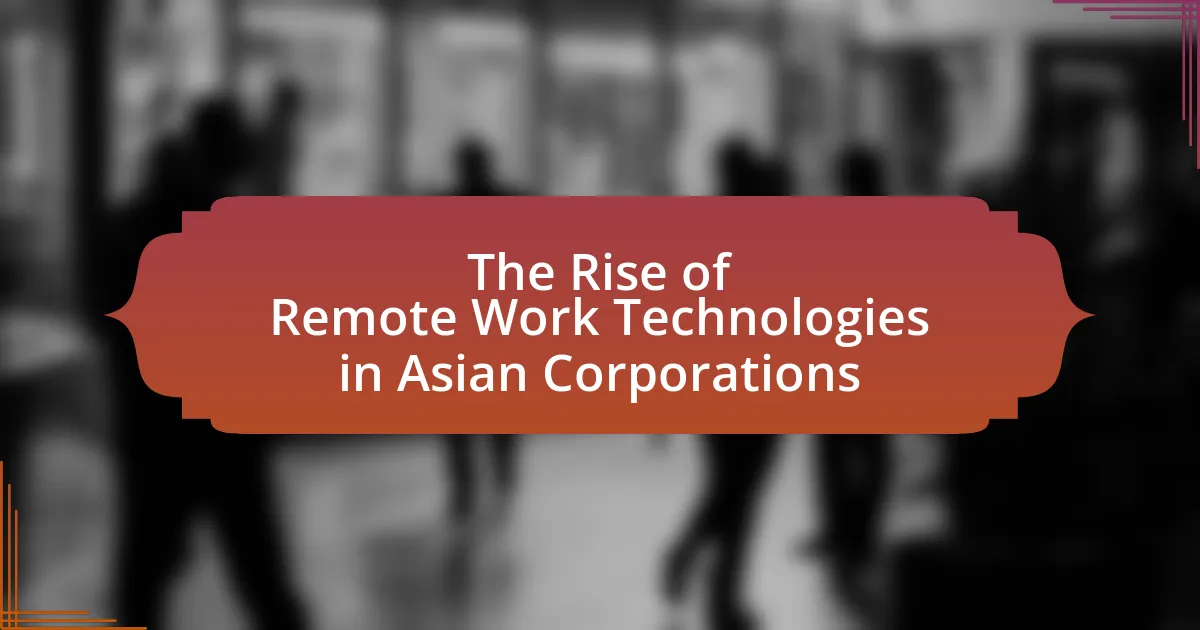Smart cities are urban areas that utilize digital technology and data analytics to improve residents’ quality of life, enhance sustainability, and optimize city services. In Asia, where rapid urbanization presents significant challenges such as traffic congestion, pollution, and resource scarcity, smart city initiatives are essential for effective urban management. The article explores how technology solutions, including IoT, big data, and AI, address these urban challenges, improve public services, and foster economic growth. It also highlights successful case studies from cities like Singapore and Seoul, emphasizing the importance of citizen engagement and public-private partnerships in developing sustainable smart city frameworks.
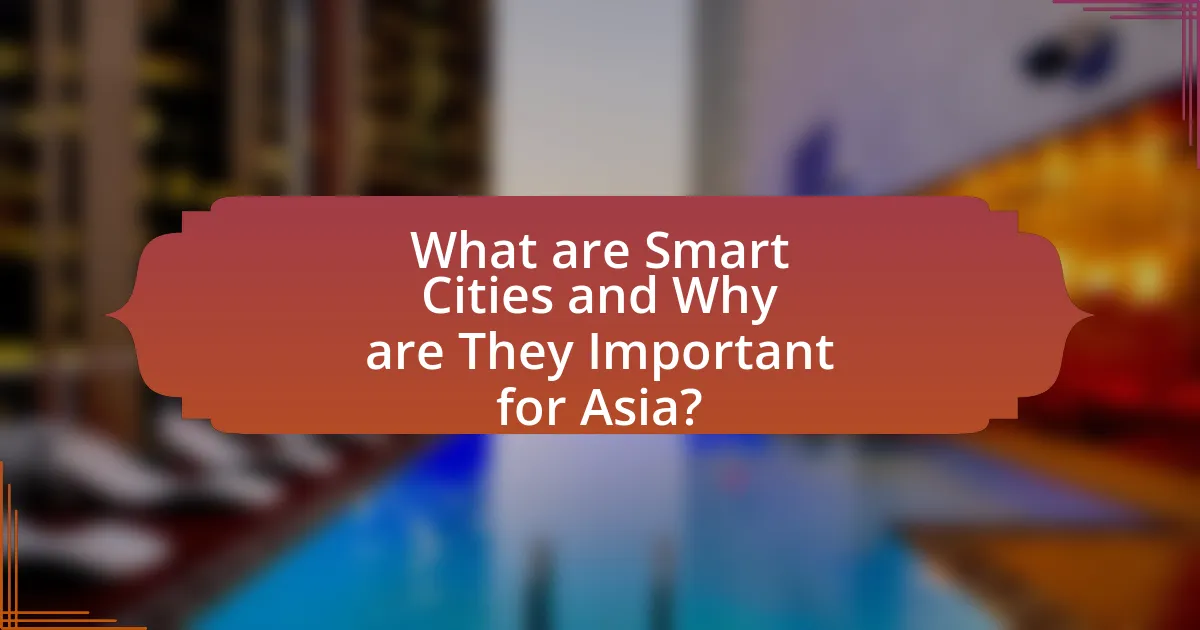
What are Smart Cities and Why are They Important for Asia?
Smart cities are urban areas that leverage digital technology and data analytics to enhance the quality of life for residents, improve sustainability, and optimize city services. In Asia, where rapid urbanization is occurring, smart cities are crucial for managing challenges such as traffic congestion, pollution, and resource scarcity. For instance, according to the United Nations, Asia is expected to host 64% of the world’s urban population by 2050, necessitating innovative solutions to ensure efficient urban management and improved living conditions.
How do Smart Cities address urban challenges in Asia?
Smart Cities in Asia address urban challenges by leveraging technology to enhance infrastructure, improve public services, and promote sustainable development. For instance, cities like Singapore utilize smart traffic management systems that reduce congestion by analyzing real-time data from vehicles and public transport, leading to a reported 15% decrease in travel time. Additionally, smart waste management systems in cities such as Seoul optimize collection routes and schedules, resulting in a 30% reduction in operational costs. These initiatives demonstrate how Smart Cities effectively tackle issues like traffic congestion and waste management through innovative technological solutions.
What specific urban challenges do Asian cities face?
Asian cities face specific urban challenges including rapid urbanization, inadequate infrastructure, pollution, and social inequality. Rapid urbanization leads to increased population density, straining housing and transportation systems; for instance, cities like Mumbai and Jakarta experience severe traffic congestion and housing shortages. Inadequate infrastructure results in insufficient public services, with many urban areas lacking reliable water supply and waste management systems. Pollution is a significant issue, as cities such as Beijing and Delhi struggle with air quality, often exceeding safe levels according to the World Health Organization. Social inequality manifests in the disparity between affluent and impoverished neighborhoods, leading to unequal access to resources and opportunities. These challenges necessitate innovative technology solutions to create sustainable and resilient urban environments.
How can technology mitigate these challenges?
Technology can mitigate challenges in developing smart cities by enhancing urban infrastructure, improving resource management, and facilitating citizen engagement. For instance, IoT (Internet of Things) devices can optimize traffic flow and reduce congestion by providing real-time data to city planners, leading to a 20-30% decrease in travel time, as evidenced by smart traffic management systems implemented in cities like Singapore. Additionally, smart grids can improve energy efficiency by integrating renewable energy sources, which can reduce carbon emissions by up to 40%, according to the International Energy Agency. Furthermore, mobile applications can foster citizen participation in governance, allowing residents to report issues and access services more efficiently, thereby increasing overall satisfaction and trust in local authorities.
What role does technology play in the development of Smart Cities?
Technology is fundamental in the development of Smart Cities by enabling efficient resource management, enhancing connectivity, and improving the quality of urban life. Smart technologies, such as Internet of Things (IoT) devices, facilitate real-time data collection and analysis, which allows city planners to optimize traffic flow, reduce energy consumption, and enhance public safety. For instance, cities like Singapore utilize smart traffic management systems that adapt to real-time conditions, resulting in a reported 15% reduction in congestion. Additionally, technology fosters citizen engagement through mobile applications that provide access to city services and information, thereby promoting transparency and participation in governance.
What are the key technologies driving Smart City initiatives?
Key technologies driving Smart City initiatives include the Internet of Things (IoT), big data analytics, artificial intelligence (AI), and smart infrastructure. IoT enables the interconnection of devices and sensors, facilitating real-time data collection and monitoring of urban systems. Big data analytics processes vast amounts of data generated by these devices, allowing for informed decision-making and improved city management. AI enhances predictive analytics and automation, optimizing resource allocation and service delivery. Smart infrastructure, such as intelligent transportation systems and energy-efficient buildings, supports sustainable urban development. These technologies collectively enhance urban living by improving efficiency, sustainability, and quality of life in cities.
How do these technologies integrate to create a Smart City ecosystem?
Technologies integrate to create a Smart City ecosystem by utilizing interconnected systems that enhance urban management and improve quality of life. For instance, Internet of Things (IoT) devices collect real-time data on traffic, energy usage, and environmental conditions, which is then analyzed to optimize city services. Additionally, data analytics platforms process this information to inform decision-making, while cloud computing provides the necessary infrastructure for data storage and accessibility. The integration of these technologies facilitates efficient resource allocation, reduces operational costs, and enhances citizen engagement through mobile applications that provide real-time updates and services. This interconnected approach has been validated by various Smart City initiatives worldwide, demonstrating improved urban sustainability and livability.
What are the potential benefits of developing Smart Cities in Asia?
Developing Smart Cities in Asia offers numerous benefits, including enhanced urban efficiency, improved quality of life, and sustainable economic growth. Smart Cities utilize technology to optimize resource management, leading to reduced energy consumption and lower operational costs. For instance, the implementation of smart grids can decrease energy waste by up to 30%, as evidenced by pilot projects in cities like Singapore. Additionally, Smart Cities can improve public services through data-driven decision-making, resulting in faster response times for emergency services and better traffic management. According to a report by the Asian Development Bank, investing in smart infrastructure can boost GDP growth by 1-2% annually in developing Asian economies. These advancements not only address urban challenges but also foster innovation and attract investment, creating a more resilient urban environment.
How can Smart Cities improve quality of life for residents?
Smart Cities can improve the quality of life for residents by integrating advanced technologies to enhance urban services and infrastructure. For instance, smart traffic management systems reduce congestion and travel time, leading to less stress and improved air quality. According to a study by the International Telecommunication Union, cities implementing smart solutions have reported a 20-30% reduction in traffic-related emissions. Additionally, smart energy grids optimize energy consumption, resulting in lower utility costs for residents. Research from the World Economic Forum indicates that smart city initiatives can increase citizen satisfaction by up to 40% through improved public services and enhanced safety measures. Overall, the deployment of technology in urban environments directly contributes to a more efficient, sustainable, and livable city for its inhabitants.
What economic advantages do Smart Cities offer to urban areas?
Smart Cities provide significant economic advantages to urban areas by enhancing efficiency, reducing operational costs, and attracting investment. These cities leverage technology to optimize resource management, such as energy and water, which can lead to cost savings of up to 30% in utility expenses. Additionally, Smart Cities create a more attractive environment for businesses, evidenced by a 2019 report from the McKinsey Global Institute, which found that cities with advanced digital infrastructure can increase their GDP by 10-30% over a decade. Furthermore, improved public services and infrastructure in Smart Cities can lead to higher property values and increased tax revenues, contributing to overall economic growth.
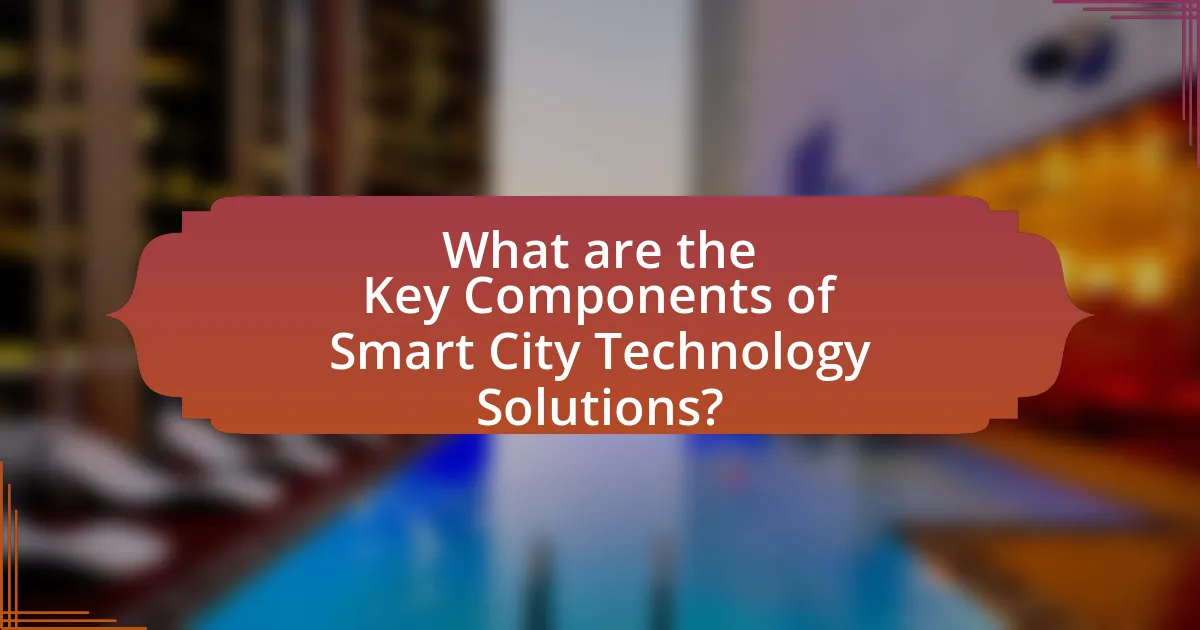
What are the Key Components of Smart City Technology Solutions?
The key components of smart city technology solutions include IoT (Internet of Things) devices, data analytics platforms, communication networks, and integrated management systems. IoT devices, such as sensors and smart meters, collect real-time data on urban infrastructure and services, enabling efficient resource management. Data analytics platforms process this data to derive actionable insights, improving decision-making for city planners. Communication networks, including 5G and fiber optics, facilitate seamless connectivity among devices and systems. Integrated management systems coordinate various city services, such as transportation, energy, and waste management, enhancing overall urban efficiency. These components collectively contribute to the development of sustainable and resilient urban environments, addressing challenges faced by cities in Asia and beyond.
What types of technology solutions are essential for Smart Cities?
Essential technology solutions for Smart Cities include Internet of Things (IoT) devices, data analytics platforms, smart transportation systems, and energy management technologies. IoT devices enable real-time data collection and monitoring, which is crucial for efficient urban management. Data analytics platforms process this data to derive actionable insights, improving decision-making and resource allocation. Smart transportation systems, such as intelligent traffic management and public transit apps, enhance mobility and reduce congestion. Energy management technologies, including smart grids and renewable energy solutions, promote sustainability and optimize energy consumption. These technologies collectively address urban challenges by improving infrastructure, enhancing quality of life, and fostering sustainable development.
How do IoT devices contribute to Smart City infrastructure?
IoT devices significantly enhance Smart City infrastructure by enabling real-time data collection and analysis, which improves urban management and resource allocation. For instance, smart sensors monitor traffic flow, allowing cities to optimize traffic signals and reduce congestion, as evidenced by a 20% decrease in travel time reported in cities implementing such systems. Additionally, IoT devices facilitate efficient energy management through smart grids, which can reduce energy consumption by up to 30% according to studies conducted by the International Energy Agency. These contributions lead to improved public services, enhanced sustainability, and better quality of life for residents in urban environments.
What role does big data play in urban planning and management?
Big data plays a crucial role in urban planning and management by enabling data-driven decision-making and enhancing the efficiency of city services. It allows urban planners to analyze vast amounts of information from various sources, such as traffic patterns, population density, and environmental conditions, leading to more informed strategies for infrastructure development and resource allocation. For instance, cities like Singapore utilize big data analytics to optimize public transport systems, resulting in a 15% increase in efficiency according to the Land Transport Authority. This data-driven approach not only improves urban mobility but also supports sustainable development by identifying areas for green space and energy-efficient buildings.
How do Smart City technologies enhance public services?
Smart City technologies enhance public services by integrating data-driven solutions that improve efficiency, accessibility, and responsiveness. For instance, smart traffic management systems utilize real-time data to optimize traffic flow, reducing congestion and travel times, which directly benefits public transportation services. Additionally, IoT-enabled waste management systems monitor bin levels and optimize collection routes, leading to cost savings and improved sanitation services. According to a report by the McKinsey Global Institute, cities that adopt smart technologies can reduce operational costs by up to 30%, demonstrating the tangible benefits of these innovations in enhancing public services.
What innovations are being implemented in transportation systems?
Innovations being implemented in transportation systems include the integration of smart traffic management systems, electric and autonomous vehicles, and mobility-as-a-service platforms. Smart traffic management systems utilize real-time data analytics to optimize traffic flow and reduce congestion, as evidenced by cities like Singapore, which has seen a 15% decrease in travel time due to such systems. Electric vehicles are being adopted to reduce emissions, with countries like China leading the way, having over 5 million electric vehicles on the road as of 2022. Autonomous vehicles are being tested in various urban environments, with companies like Waymo and Tesla advancing this technology significantly. Mobility-as-a-service platforms, such as Grab and Gojek, are transforming urban transportation by providing integrated services that combine public transit, ride-hailing, and bike-sharing, enhancing accessibility and convenience for users.
How can Smart City solutions improve energy management?
Smart City solutions can improve energy management by integrating advanced technologies such as IoT, data analytics, and smart grids to optimize energy consumption and distribution. These technologies enable real-time monitoring of energy usage, allowing cities to identify inefficiencies and implement demand-response strategies. For instance, a study by the International Energy Agency indicates that smart grids can reduce energy losses by up to 30% through better management of electricity flow and enhanced grid reliability. Additionally, smart meters provide consumers with detailed usage data, empowering them to make informed decisions about their energy consumption, which can lead to a reduction in overall demand.
What challenges do cities face when implementing Smart City technologies?
Cities face several challenges when implementing Smart City technologies, including high costs, data privacy concerns, and the need for infrastructure upgrades. The financial burden of deploying advanced technologies can strain municipal budgets, as cities must invest in new systems and training for personnel. Additionally, the collection and management of vast amounts of data raise significant privacy issues, as citizens may be wary of surveillance and data misuse. Furthermore, many cities require substantial upgrades to existing infrastructure to support new technologies, which can be logistically complex and time-consuming. These challenges are documented in various studies, including the “Smart Cities: A Global Perspective” report by the McKinsey Global Institute, which highlights the financial and operational hurdles cities encounter in adopting Smart City initiatives.
What are the common barriers to technology adoption in urban areas?
Common barriers to technology adoption in urban areas include high costs, lack of infrastructure, digital literacy gaps, and regulatory challenges. High costs can deter both individuals and businesses from investing in new technologies, as seen in cities where budget constraints limit access to advanced solutions. Lack of infrastructure, such as inadequate internet connectivity, hampers the implementation of smart technologies, particularly in densely populated regions. Digital literacy gaps create disparities in technology usage, with many residents unable to effectively engage with new systems. Regulatory challenges, including outdated policies and bureaucratic hurdles, can slow down the adoption process, as evidenced by various urban initiatives facing delays due to compliance issues.
How can cities overcome resistance to change in Smart City initiatives?
Cities can overcome resistance to change in Smart City initiatives by actively engaging stakeholders through transparent communication and inclusive decision-making processes. This approach fosters trust and encourages community buy-in, which is essential for the successful implementation of new technologies. Research indicates that cities that involve citizens in the planning stages, such as through public forums or surveys, experience higher acceptance rates for Smart City projects. For example, Barcelona’s Smart City strategy included extensive public consultation, resulting in increased public support and participation in initiatives. By prioritizing stakeholder engagement and addressing concerns directly, cities can effectively mitigate resistance and enhance the success of their Smart City initiatives.
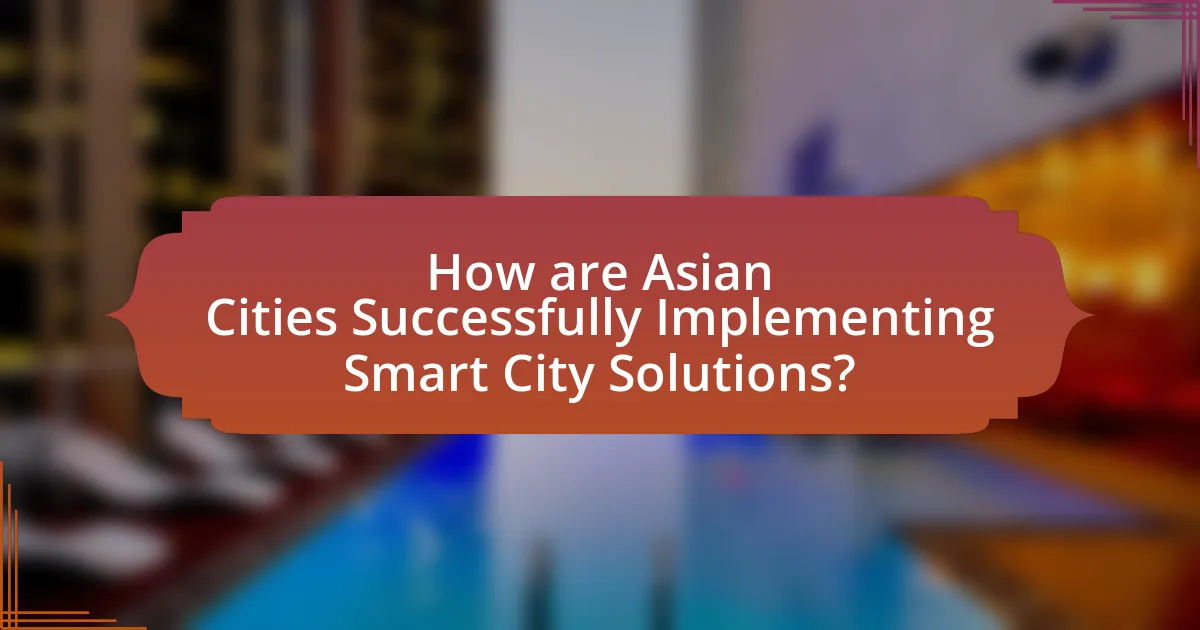
How are Asian Cities Successfully Implementing Smart City Solutions?
Asian cities are successfully implementing smart city solutions through the integration of advanced technologies such as IoT, AI, and big data analytics to enhance urban management and improve the quality of life for residents. For instance, Singapore utilizes a comprehensive smart traffic management system that employs real-time data to optimize traffic flow, reducing congestion by 15% according to the Land Transport Authority. Additionally, cities like Seoul have adopted smart waste management systems that use sensors to monitor waste levels, leading to a 30% reduction in collection costs. These implementations demonstrate a strategic approach to urban challenges, leveraging technology to create more efficient, sustainable, and livable environments.
What are some successful case studies of Smart Cities in Asia?
Successful case studies of Smart Cities in Asia include Singapore, Seoul, and Hangzhou. Singapore’s Smart Nation initiative integrates technology across urban services, enhancing public transport and energy efficiency, evidenced by a 30% reduction in energy consumption in smart buildings. Seoul’s Smart City project utilizes data analytics for traffic management, resulting in a 20% decrease in congestion. Hangzhou’s City Brain initiative employs AI to optimize urban management, leading to a 15% improvement in emergency response times. These examples demonstrate effective implementation of technology to address urban challenges in Asia.
What lessons can be learned from Singapore’s Smart Nation initiative?
Singapore’s Smart Nation initiative teaches the importance of integrating technology with urban planning to enhance quality of life. The initiative emphasizes the need for a collaborative approach among government, private sector, and citizens to drive innovation and address urban challenges. For instance, the use of data analytics in public services has improved efficiency and responsiveness, as seen in the implementation of smart traffic management systems that reduce congestion. Additionally, the initiative highlights the significance of investing in digital infrastructure, as Singapore has established a robust network that supports various smart applications, demonstrating that a strong technological foundation is crucial for successful smart city development.
How has Seoul integrated technology into its urban development plans?
Seoul has integrated technology into its urban development plans through initiatives like the Smart City project, which utilizes data analytics, IoT, and AI to enhance urban living. The city has implemented a comprehensive data-driven approach, exemplified by the establishment of the Seoul Smart City Master Plan, which aims to improve transportation, energy efficiency, and public safety. For instance, the city employs smart traffic management systems that use real-time data to optimize traffic flow, reducing congestion by up to 30%. Additionally, Seoul’s use of digital platforms for citizen engagement allows residents to participate in urban planning processes, ensuring that technological advancements align with community needs.
What strategies are cities using to engage citizens in Smart City projects?
Cities are employing various strategies to engage citizens in Smart City projects, including participatory planning, digital platforms for feedback, and community workshops. Participatory planning allows residents to contribute to decision-making processes, ensuring their needs and preferences are considered. Digital platforms, such as mobile apps and websites, facilitate real-time feedback and communication between citizens and city officials, enhancing transparency and responsiveness. Community workshops provide a space for dialogue, education, and collaboration, fostering a sense of ownership among residents. These strategies have been shown to increase citizen involvement and satisfaction in urban development initiatives.
How can public participation enhance Smart City initiatives?
Public participation can enhance Smart City initiatives by fostering community engagement and ensuring that the needs and preferences of residents are integrated into urban planning. Engaging citizens in decision-making processes leads to more relevant and effective solutions, as evidenced by the success of participatory budgeting in cities like Seoul, where public input resulted in projects that directly addressed local concerns. Additionally, public participation can improve transparency and accountability, as seen in Barcelona’s Smart City strategy, which actively involves citizens in monitoring and evaluating urban services. This collaborative approach not only builds trust between residents and city officials but also encourages innovation by leveraging diverse perspectives and local knowledge.
What role do partnerships with private sectors play in Smart City development?
Partnerships with private sectors are crucial in Smart City development as they provide essential funding, technological expertise, and innovative solutions. These collaborations enable cities to leverage private investment for infrastructure projects, such as smart transportation systems and energy-efficient buildings, which are often beyond the financial capacity of public entities alone. For instance, the partnership between the city of Barcelona and various tech companies has led to the implementation of smart lighting and waste management systems, significantly improving urban efficiency and sustainability. Such collaborations not only enhance service delivery but also foster a competitive environment that drives continuous improvement and innovation in urban management.
What best practices should cities follow when developing Smart Cities?
Cities should prioritize citizen engagement and data-driven decision-making when developing Smart Cities. Engaging citizens ensures that the technologies implemented meet the actual needs of the community, fostering a sense of ownership and trust. For instance, cities like Barcelona have successfully involved residents in the planning process, leading to more effective solutions tailored to local challenges. Additionally, utilizing data analytics allows cities to optimize resources and improve services, as seen in Singapore, where data-driven policies have enhanced public transportation efficiency. These practices not only enhance the quality of life but also promote sustainable urban development.
How can cities ensure sustainability in their Smart City projects?
Cities can ensure sustainability in their Smart City projects by integrating renewable energy sources, optimizing resource management, and promoting sustainable transportation options. For instance, implementing solar panels and wind turbines can significantly reduce carbon footprints, as evidenced by cities like San Diego, which aims for 100% renewable energy by 2035. Additionally, utilizing smart grids and IoT technologies can enhance water and energy efficiency, demonstrated by Barcelona’s smart water management system that reduces waste by 25%. Furthermore, encouraging public transit and electric vehicle infrastructure can lower emissions, as seen in Singapore’s extensive public transport network that serves over 7 million rides daily. These strategies collectively contribute to the long-term sustainability of urban environments.
What are the key considerations for future-proofing Smart City technologies?
Key considerations for future-proofing Smart City technologies include scalability, interoperability, and sustainability. Scalability ensures that technologies can grow and adapt to increasing urban populations and demands, as evidenced by cities like Singapore, which have successfully expanded their smart infrastructure to accommodate growth. Interoperability allows different systems and devices to communicate effectively, which is crucial for seamless integration; for instance, the use of open standards in Barcelona’s smart lighting system facilitates compatibility with various technologies. Sustainability focuses on minimizing environmental impact and promoting energy efficiency, as demonstrated by initiatives in Copenhagen that prioritize green technologies and renewable energy sources. These considerations are essential for creating resilient and adaptable urban environments.
